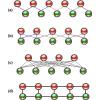当前位置:
X-MOL 学术
›
Phys. Rev. E
›
论文详情
Our official English website, www.x-mol.net, welcomes your
feedback! (Note: you will need to create a separate account there.)
Simulating disordered quantum Ising chains via dense and sparse restricted Boltzmann machines.
Physical Review E ( IF 2.2 ) Pub Date : 2020-06-22 , DOI: 10.1103/physreve.101.063308 S Pilati 1 , P Pieri 1, 2
Physical Review E ( IF 2.2 ) Pub Date : 2020-06-22 , DOI: 10.1103/physreve.101.063308 S Pilati 1 , P Pieri 1, 2
Affiliation

|
In recent years, generative artificial neural networks based on restricted Boltzmann machines (RBMs) have been successfully employed as accurate and flexible variational wave functions for clean quantum many-body systems. In this article, we explore their use in simulations of disordered quantum Ising chains. The standard dense RBM with all-to-all interlayer connectivity is not particularly appropriate for large disordered systems, since in such systems one cannot exploit translational invariance to reduce the amount of parameters to be optimized. To circumvent this problem, we implement sparse RBMs, whereby the visible spins are connected only to a subset of local hidden neurons, thus reducing the amount of parameters. We assess the performance of sparse RBMs as a function of the range of the allowed connections, and we compare it with that of dense RBMs. Benchmark results are provided for two sign-problem-free Hamiltonians, namely pure and random quantum Ising chains. The RBM Ansätzes are trained using the unsupervised learning scheme based on projective quantum Monte Carlo (PQMC) algorithms. We find that the sparse connectivity facilitates the training process and allows sparse RBMs to outperform their dense counterparts. Furthermore, the use of sparse RBMs as guiding functions for PQMC simulations allows us to perform PQMC simulations at a reduced computational cost, avoiding possible biases due to finite random-walker populations. We obtain unbiased predictions for the ground-state energies and the magnetization profiles with fixed boundary conditions, at the ferromagnetic quantum critical point. The magnetization profiles agree with the Fisher–de Gennes scaling relation for conformally invariant systems, including the scaling dimension predicted by the renormalization-group analysis.
中文翻译:

通过密集稀疏的Boltzmann机器模拟无序量子Ising链。
近年来,基于受限玻尔兹曼机(RBM)的生成人工神经网络已成功用作清洁量子多体系统的精确且灵活的变分波函数。在本文中,我们探索了它们在无序量子伊辛链模拟中的应用。具有全部到所有层间连接的标准密集RBM不适用于大型无序系统,因为在这样的系统中,人们无法利用平移不变性来减少要优化的参数数量。为了解决此问题,我们实现了稀疏RBM,将可见的自旋仅连接到局部隐藏神经元的子集,从而减少了参数数量。我们根据允许的连接范围来评估稀疏RBM的性能,并将其与密集的RBM进行比较。提供了两个无符号问题的哈密顿量的基准结果,即纯量子伊辛链和随机量子伊辛链。注重成果的管理Ansätzes使用基于投影量子蒙特卡洛(PQMC)算法的无监督学习方式训练。我们发现稀疏的连接性有助于训练过程,并允许稀疏的RBM胜过其密集的RBM。此外,使用稀疏RBM作为PQMC模拟的指导功能使我们能够以降低的计算成本执行PQMC模拟,避免了由于有限的随机游走人口而造成的可能偏差。我们在铁磁量子临界点获得了具有固定边界条件的基态能量和磁化曲线的无偏预测。磁化曲线与共形不变系统的Fisher-de Gennes标度关系一致,包括通过归一化组分析预测的标度尺寸。
更新日期:2020-06-22
中文翻译:

通过密集稀疏的Boltzmann机器模拟无序量子Ising链。
近年来,基于受限玻尔兹曼机(RBM)的生成人工神经网络已成功用作清洁量子多体系统的精确且灵活的变分波函数。在本文中,我们探索了它们在无序量子伊辛链模拟中的应用。具有全部到所有层间连接的标准密集RBM不适用于大型无序系统,因为在这样的系统中,人们无法利用平移不变性来减少要优化的参数数量。为了解决此问题,我们实现了稀疏RBM,将可见的自旋仅连接到局部隐藏神经元的子集,从而减少了参数数量。我们根据允许的连接范围来评估稀疏RBM的性能,并将其与密集的RBM进行比较。提供了两个无符号问题的哈密顿量的基准结果,即纯量子伊辛链和随机量子伊辛链。注重成果的管理Ansätzes使用基于投影量子蒙特卡洛(PQMC)算法的无监督学习方式训练。我们发现稀疏的连接性有助于训练过程,并允许稀疏的RBM胜过其密集的RBM。此外,使用稀疏RBM作为PQMC模拟的指导功能使我们能够以降低的计算成本执行PQMC模拟,避免了由于有限的随机游走人口而造成的可能偏差。我们在铁磁量子临界点获得了具有固定边界条件的基态能量和磁化曲线的无偏预测。磁化曲线与共形不变系统的Fisher-de Gennes标度关系一致,包括通过归一化组分析预测的标度尺寸。











































 京公网安备 11010802027423号
京公网安备 11010802027423号